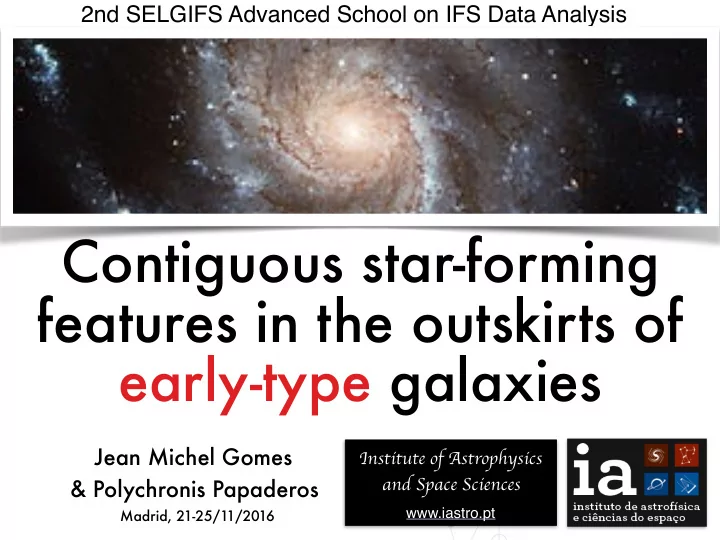

2nd SELGIFS Advanced School on IFS Data Analysis on Integral-Field Spectroscopy Data Analysis Contiguous star-forming features in the outskirts of early-type galaxies Jean Michel Gomes Institute of Astrophysics and Space Sciences & Polychronis Papaderos Madrid, 21-25/11/2016 www.iastro.pt
Team P. Papaderos* J.M. Vílchez C. Kehrig J. Iglesias-Páramo I. Breda* M. Lehnert S.F. Sánchez B. Ziegler S. Reis* and the CALIFA collaboration
HEADLINES 1. Overview Pop. Synthesis, ETGs & IFU 2. Porto3D tool 3. IFU analysis of 32 ETGs * Type i, i+ & ii 4. features in ETGs? 5. Final remarks & Tasks
1.Overview Theoretical Background
Population Synthesis What is population synthesis? ◎ Similarity with Paleontology ◎ Analysis of the fossil records of galaxies, i.e. the previous generations of stars YOUNG INT. OLD 5
Population Synthesis What is population synthesis? ◎ Similarity with Paleontology ◎ Analysis of the fossil records of galaxies, i.e. the previous generations of stars YOUNG INT. OLD 6
Population Synthesis What is population synthesis? ◎ Similarity with Paleontology ◎ Analysis of the fossil records of galaxies, i.e. the previous generations of stars YOUNG F( λ ) = Ʃ j M j L j ( λ ) 10 -0.4A λ ⨂ G(v ★ , σ ★ ) + other terms to model the spectrum INT. OLD 7
Population Synthesis What is population synthesis? Starlight code (Cid Fernandes et al. 2005) F( λ ) λ [Å] 8
Baldwin, Phillips & Terlevich (1981) Seyfert LINER Kauffmann et al. (2003c) star-forming Kewley et al. (2001) SDSS - DR7 9
1.Overview Observational - ETGs Early-Type Galaxies 10
1.Overview Observational - ETGs Early-type galaxies (ETGs) ◎ Deceptively simple ◎ Ellipsoids ◎ Simple stellar population ~ globular clusters ◎ Age of the order of 10 Gyr ◎ LINER characteristics 11
1.Overview Observational - ETGs Early-type galaxies (ETGs) * What is the nature of the warm interstellar medium in ETGs? AGN? Post-AGB stars? Residual SF? Shocks? * Faint Nebular Emission - EW(H α ) <~ 3Å - Usually compatible with Low Ionization nuclear emission-line regions (LINER) line-ratios in standard diagnostic diagrams * This project mainly focus on the Post-AGB component for the ionization mechanism in ETGs 12
1.Overview Observational - IFU Data cube illustration from CALIFA 13
2.Porto3D - IFU Tool developed at IA - Papaderos & Gomes Described in Gomes et al. 2016a Step 3 Step 1 Computation Pre- of τ for pAGB Processing Step2 Emission- line maps ◎ MODULAR structure ◎ STARLIGHT spectral synthesis code ◎ ESO-MIDAS + Fortran standalone routines 14
Ex.: Porto3D - NGC 171 arcsec arcsec H α Flux H α EW arcsec arcsec mean ☆ age mass mean ☆ age light 15 arcsec arcsec
3. IFU analysis of 32 ETGs Gomes et al. 2016a 16
Type i, i+ and ii Nucleus Extranuclear EW (H α ) Galactocentric Radius Tentative classification scheme based on distinct EW zones Type i 64 % S0’s : radially constant <EW(H α )> ~ 1Å Type i+ 100% S0’s : ~10% of all ETGs in our sample Type ii 78 % E’s : very low (< 0.5 Å) EW(H α ) with positive radial gradients 17
Subclass Type i+ H α Flux Way above H α EW the threshold for pAGB photoionization in the outskirts 18
NGC 1167 4. Spiral-like features in ETGs? Gomes, Papaderos et al. 2016b Vol. 585, A92 January 2016, DOI: 10.1051/0004-6361/201525974 19
Type i+ examples SDSS images Gomes, Papaderos et al. 2016b NGC 1167 NGC 1349 NGC 3106 EW ( H α ) 20 ☉ SSFR ~ 10 -12 yr -1 & SFR ~ 0.1-0.3 M yr -1 - S0
5 . Final Remarks 1) Spatially resolved analysis in type i+ galaxies 2) Faint spiral-like star-forming features detected in the outskirts of local type i+ ETGs ( ∼ 10% of the sample). 3) Empirical assessment of BPT emission-lines and aperture effects using CALIFA IFS data for type i+ & theoretical study based on a simple inside-out galaxy growth model. 21
5 . Tasks for this project Photometric analysis (computation and subtraction of a 2D model) will be provided to the students using the unsharp- masked images. Identify spaxels within spiral-like SF features for NGC 0932 (NGC 0787 if time available ) NGC 0932 NGC 0787 22
5 . Tasks for this project 1- First task Based on 3D observed data cubes corrected for the systemic galaxy velocity (*_3D_OBS) Extract and sum-up the spectra from spaxels within spiral features (see photometric images). i) These summed-up spectra (corrected for the systemic galaxy velocity) will then be modeled with STARLIGHT, and the stellar SED will be subtracted in order to isolate the nebular emission. ii) From which finally BPT line-ratios have to be derived in order to confirm that H-alpha emission in the spiral-like arms/rims is due to photoionization by young OB stars. 23
5 . Tasks for this project 2- Second task Apply on this summed-up spectra RemoveYoung (see presentation on Wednesday) and discuss the effect that removal of the young stellar component has on the spectrum. 24
25
Recommend
More recommend